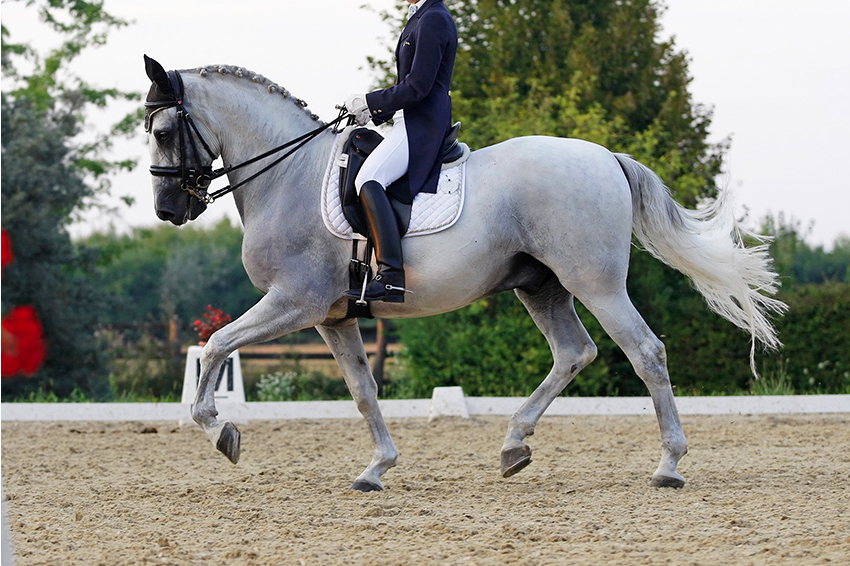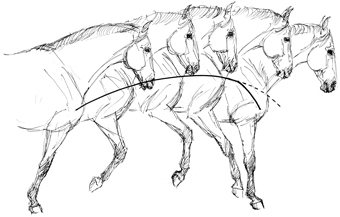How to put backbone into horse training

A fundamental rule of horse training under saddle is that your horse has to "engage through the back". However, the background of this principle is unfamiliar to many riders and even trainers. And if you want to find out what exactly this expression means, you will soon notice that people often argue with empty phrases that lack any background knowledge. This is very unfortunate, because behind those words lies a strong influence on the health, motivation and zest for life of the horse.
Only when horses engage through the back they stand up to any kind of performance. Unfortunately, we see more horses today that do not engage through the back than those that really do use their back to relieve the joints and load-bearing structures. And this even at the very top of the world's equestrian sport. The trend of riding without engaging through the back has become socially acceptable, much to the regret of the horses. The fact that this is also partly taught in this way indicates that the modern horse is trained according to outdated methods, which should be reconsidered in view of today’s breeding results.
In the face of the wide range of different breeds and the multitude of traditional, modern breeding lines, do we today have to flirt with the art of riding of 500 years ago? Shouldn't we first of all try to understand our horses of today? It remains to be seen whether everything was better in the past. If you look at the saddles and bits that were used in earlier centuries, certain doubts are certainly justified. Nevertheless, it is clear that the horses had different tasks back then: The noble ladies and gentlemen needed noble steeds, which made it easy for them to stroll in the parks chatting on solidly trained horses, which responded to fine aids and were calm and easy. It was the time of social pleasure and representation; it was the time of baroque. Is that still possible today?
Today, riding is no longer limited to a social elite who have their horses trained by experienced masters of their trade. Today, riding is a popular sport, which means that not only well-trained professionals and sportsmen and sportswomen take a seat in the saddle.
At the same time, horse breeding has developed strongly throughout the last decades, in some cases to the limit of torture breeding. The modern horses of almost all breeds, whether warmbloods, Iberian or Icelandic horses, are hypermobile, i.e. excessively mobile, and at the same time have enormous driving power in the hindquarters. These horses inspire the ignorant observer as foals and young horses with their sweeping movements. But behind closed doors, breeders and trainers have long since agreed that things cannot go on like this. Hypermobility coupled with exuberant driving power is a dangerous mixture that leads to instability in the body, which sooner or later puts the riding horse under a great deal of strain in terms of health. The horse is simply overwhelmed with its own movements and the additional strain imposed by the rider. Instinctively it seeks strategies to literally stay on its feet. It tenses up, builds up compensation muscles and soon becomes stiff throughout the body. This tense and compensatory musculature gives the horse support, but makes physiologically functional movement difficult. The horse's potential falls by the wayside, inexplicable stress behavior and unwillingness to move develops, so that rideability becomes a burden for the owner. Connected with this, the harbingers of health problems appear: impurities in the rhythm, lameness without medical cause or even metabolic problems.
What does all this have to do with the back? The back as the center of movement must be trained in such a way that it swings upwards, thereby removing from the joints the burden of the shear and centrifugal forces, but also of the rider's weight. The entire topline of the horse must be trained to become a functional unit which, together with its counterpart, the abdominal and chest muscles, distributes loads in a springy manner. To achieve this the fundamental element needs to be the flexion of haunches, which results in lifting the trunk and a healthy stretching posture.
The neck plays a decisive role in this! Only when it no longer needs to be used as a "steering-wheel" or "balancing pole" can it be functionally integrated into the body in full thoroughness and suppleness. In the next step, the carrying power, which is essential to achieve long-term health and competitiveness, can be developed from the innate driving power. Now the horse is able to step under the center of gravity with the hindquarters, to achieve an elevation of the forehand through an engaged back – the commonly called "uphill" movement – and to stretch out to the bit. At all times, the contact must remain light, the back supple and swinging.
The engagement through the back is an absolutely essential element of horse-friendly riding and must be maintained up to the most difficult exercises! Collection is the perfection of functional training with maximum weight carrying of the hindquarters and power transmission through the back in order to create a light and constant contact.
Horses that engage correctly through the back are high-performance athletes. No less is expected from their riders! However, many horse owners today are no longer able to ride horses that engage through the back – they themselves lack athleticism, i.e. stability and mobility. If you don't want to disturb in its movements a horse that engages through the back, but you rather want to support it, you yourself need, among other things, good abdominal and back muscles for a balanced, rein-independent seat. Riding a horse with tension in its back is therefore less demanding for the rider. However, in view of the health risks for the horse, such equestrian laziness, which some riders and trainers consciously accept, seems more than questionable from an ethical point of view. Out of respect for our loyal four-legged friends, it is our duty as riders to be fit enough to ride horses that engage through the back. They will thank us for it.

